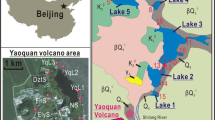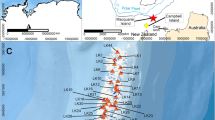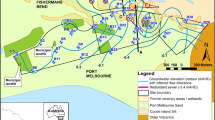Abstract
The Lake Connewarre Complex is an internationally protected wetland in southeast Australia, undergoing increasing environmental change due to urbanisation. Stable isotopes of water (δ18O and δ2H) and other geochemical indicators were used to assess sources of water and salinity in the shallow groundwater and surface-water systems, and to better understand groundwater/surface-water interactions. While much of the shallow groundwater is saline (from 1.27 to 50.3 g/L TDS) with overlapping salinities across water groups, stable isotopes allow clear delineation of two distinct sources of water and salinity: marine water with δ18O between −1.4 and +1.3 ‰ and ion ratios characteristic of seawater; and meteoric water with δ18O between −6.1 and −3.6 ‰ containing cyclic salts, probably concentrated by plant transpiration. Groundwater bodies in shallow sediments beneath the wetlands have salinities and stable isotopic compositions intermediate between fresh wetland surface water and a marine water end-member. This marine-type water is likely relict seawater emplaced when the wetlands were connected to the estuary, prior to modern river regulation. Freshwater input to underlying groundwater is a recent consequence of this regulation. Future predicted changes such as increased stormwater inflow, will increase rates of freshwater leakage to shallow groundwater, favouring the proliferation of exotic reed species.
Résumé
Le complexe du Lac Connewarre est une zone humide, internationalement protégée dans le sud-est de l'Australie, subissant le changement environnemental croissant en raison de l'urbanisation. Les isotopes stables d'eau (δ18O et δ2H) et d'autres indicateurs géochimiques ont été utilisés pour évaluer l’origine de l'eau et la salinité dans les systèmes aquifères superficiels et les eaux de surface, et pour mieux comprendre les interactions entre les eaux souterraines et les eaux de surface. Tandis qu'une grande partie de l'eau superficielle souterraine est saline (de 1.27 à 50.3 g/L TDS) avec des salinités se chevauchant à travers les groupes d'eau, les isotopes stables permettent une claire différenciation entre deux sources distinctes d'eau et de salinité: l’eau marine avec un δ18O entre −1.4 et 1.3 ‰ et des rapports ioniques caractéristiques de l'eau de mer; et l’eau météorique avec un δ18O entre −6.1 et –3.6 ‰ contenant des sels cycliques, probablement concentrés par la transpiration végétale. Les masses d'eau souterraine contenues dans les sédiments superficiels situés au-dessous des zones humides ont des salinités et des compositions en isotopes stables intermédiaires entre les deux pôles de mélange que sont les eaux de la zone humide et les eaux marines. Ce faciès d’eau marine correspond probablement à de l’eau de mer résiduelle mise en place lorsque la zone humide était connectée à l’estuaire, avant le régime fluvial actuel. L'apport d'eau douce à l'eau souterraine sous-jacente est une conséquence récente de ce régime. Les changements prévus dans le futur, comme une augmentation d’apports d'eaux pluviales, augmentera la proportion d’eau douce s’infiltrant dans l’aquifère superficiel, favorisant la prolifération d'espèces de roseaux exotiques.
Resumen
El Complejo del Lago Connewarre es un humedal protegido internacionalmente en el sudeste de Australia, sometido a cambios ambientales crecientes debido a la urbanización. Se utilizaron los isótopos estables del agua (δ18O y δ2H) y otros indicadores geoquímicos para evaluar las fuentes de agua y la salinidad en los sistemas de agua subterránea somera y agua superficial, y para una mejor comprensión de las interacciones agua superficial / agua subterránea. Mientras que mucha del agua subterránea somera es salina (de 1.27 a 50.3 g/L TDS) con salinidades superpuestas a través de los grupos de agua, los isótopos estables permiten una delimitación clara de dos fuentes distintas de agua y salinidad: agua marina con δ18O entre −1.4 y +1.3 ‰ y relaciones iónicas características del agua de mar; y agua meteórica con δ18O entre −6.1 y −3.6 ‰ conteniendo sales cíclicas, probablemente concentrada por la transpiración de las plantas. Los cuerpos de agua subterránea en sedimentos someros por debajo del humedal tienen salinidades y composición de los isótopos estables intermedia entre el agua superficial dulce del humedal y el agua marina. Este tipo de agua marina es probablemente un relicto de agua de mar emplazada cuando los humedales se conectaron al estuario, antes de la regulación moderna del río. La entrada de agua dulce al agua subterránea subyacente es una consecuencia reciente de esta regulación. Los cambios futuros predichos, tales como un incremento en la entrada de aguas pluviales, incrementarán las tasas de filtración de agua dulce hacia el agua subterránea somera, favoreciendo la proliferación de especies exóticas de cañaverales.
摘要
Connewarre湖及其周边地区是澳大利亚东南部一个国际上受保护的的湿地,由于城市化进程,现正经历着越来越多的环境变化。水中的稳定同位素(δ18O 和 δ2H)及其它地球化学指示物用来评价浅层地下水和地表水系统中水和盐分的来源,更好地了解地下水/地表水的相互作用。当大量浅层地下水遭遇盐分呈咸水时(TDS从1.27 到 50.3 g/L),稳定同位素可以清楚地描述水和盐分不同的来源:δ18O为–1.4至 + 1.3 ‰及具有海水离子比值特征的海相水;含循环盐分、δ18O为–6.1至–3.6 ‰的大气水,所含盐分可能由植物的蒸腾浓缩而成。湿地之下浅层沉积物中的地下水体所含盐分和稳定同位素组分处于湿地地表淡水和海相水端元之间。这种海相类型的水可能是现代河流调整前湿地连接河口时存留的残余海水。淡水注入到下伏的地下水就是这种调整的最近结果。所预测的未来变化,如雨水流入量的增加,将增加淡水渗漏到浅层地下水中的水量,有利于外来芦苇物种的生长。
Resumo
O Complexo do Lago Connewarre é uma zona húmida protegida internacionalmente no sudoeste da Austrália, sujeito a constantes alterações ambientais devidas à urbanização. Foram usados isótopos estáveis da água (δ18O e δ2H) e outros indicadores geoquímicos para avaliar as origens da água e da salinidade nos sistemas de água subterrânea subsuperficiais e nos sistemas de água superficial, de modo a compreender melhor a interação águas subterrâneas/águas superficiais. Embora grande parte da água subterrânea subsuperficial seja salina (1.27–50.3 g/L SDT), com sobreposição de salinidades entre grupos de águas, isótopos estáveis permitem uma clara delimitação de duas fontes distintas de água e de salinidade: água marinha com δ18O entre −1.4 e +1.3 ‰ e proporções de iões caraterísticos da água do mar; e água meteórica com δ18O entre −6.1 e −3.6 ‰, contendo sais cíclicos, provavelmente concentrados por transpiração das plantas. As massas de água subterrânea em sedimentos subsuperficiais por baixo das zonas húmidas têm salinidades e composições isotópicas intermédias entre as águas doces superficiais das zonas húmidas e os membros finais das águas marinhas. Esta água tipo marinha parece ser água marinha fóssil retida quando as zonas húmidas estavam ligadas ao estuário, antes de regulação do rio em tempos recentes. A contribuição de água doce para as águas subterrâneas é uma consequência recente desta regulação. As alterações previsíveis no futuro, tais como o incremento de influxo de água de tempestades, incrementarão as taxas de percolação de água doce para os aquíferos subsuperficiais, favorecendo a proliferação de espécies de plantas exóticas nas zonas húmidas.









Similar content being viewed by others
References
Appelo CAJ, Postma D (2005) Geochemistry, groundwater and pollution, 2nd edn. Balkema, Rotterdam, The Netherlands, 672 pp
Azous A, Horner RR (eds) (2010) Wetlands and urbanization: implications for the future. CRC, Boca Raton, FL, 356 pp
Baker A (2003) Land use and water quality. Hydrol Process 17:2499–2501
Bellio M, Kingsford RT (2013) Alteration of wetland hydrology in coastal lagoons: implications for shorebird conservation and wetland restoration at a Ramsar site in Sri Lanka. Biol Conserv 167:57–68
Belperio AP, Harvey N, Bourman RP (2002) Spatial and temporal variability in the Holocene sea-level record of the South Australian coastline. Sediment Geol 150:153–169
Bird ECF (1993) The coast of Victoria: the shaping of scenery. Melbourne University Press, Parkville, Australia, 324 pp
Carreira PM, Marques JM, Nunes D (2014) Source of groundwater salinity in coastline aquifers based on environmental isotopes (Portugal): natural vs. human interference—a review and reinterpretation. Appl Geochem 41:163–175
Cartwright I, Weaver TR, Fifield LK (2006) Cl/Br ratios and environmental isotopes as indicators of recharge variability and groundwater flow: an example from the southeast Murray Basin, Australia. Chem Geol 231:38–56
Chilton J (ed) (1999) Groundwater in the urban environment: selected city profiles. International Contributions to Hydrogeology (International Association of Hydrogeologists), vol 21. Balkema, Amsterdam, 342 pp
Corangamite Catchment Management Authority (2013) Seasonal watering proposal for the lower Barwon Wetlands 2013–2014 (draft). Corangamite CMA, Colac, VIC, Australia, 40 pp
Dahlhaus PG, Billows CA, Carey SP, Gwyther J, Nathan E (2007) Lake Connewarre values project: literature review. Corangamite CMA, Colac, VIC, Australia, 127 pp
Dawson TE, Ehleringer JR (1998) Plants, isotopes and water use: a catchment-scale perspective. In: Kendall C, McDonnel JJ (eds) Isotope tracers in catchment hydrology. Elsevier, Amsterdam, 839 pp
Dept. of Environment and Primary Industries Victoria (2013) Victorian biodiversity atlas. http://www.depi.vic.gov.au/environment-and-wildlife/biodiversity/victorian-biodiversity-atlas. Accessed November 2013
Ecological Assoc. (2006) Reedy lake groundwater and ecology investigation. Report for Corangamite CMA and Parks Victoria, EA Report BX003-B, Corangamite CMA, Colac, VIC, Australia, 27 pp
Fallon SJ, Fifield LK, Chappell JM (2010) The next chapter in radiocarbon dating at the Australian National University: status report on the single stage AMS. Nucl Inst Methods Phys Res B 268:898–901
Fan Y, Li H, Miguez-Macho G (2013) Global patterns of groundwater table depth. Science 339:940–943
Foster SSD, Lawrence AR, Morris BL (1998) Groundwater in urban development: assessing management needs and formulating policy strategies. World Bank technical paper 390, The World Bank, Washington, DC, 58 pp
Gattacceca JC, Vallet-Coulomb CV, Mayer A, Claude C, Radakovitch O, Conchetto E, Hamelin B (2009) Isotopic and geochemical characterisation of salinization in the shallow aquifers of a reclaimed subsiding zone: the southern Venice lagoon coastland. J Hydrol 378:46–61
Ghassemi F, Jakeman AJ, Nix HA (1995) Salinisation of land and water resources: human causes, extent, management and case studies. University of New South Wales Press, Sydney, 526 pp
Gill ED, Lane LN (1985) Sea level and aboriginal oyster middens at Lake Connewarre. Proc Roy Soc Victoria 48:1–10
Hatt BE, Fletcher TD, Walsh CJ, Taylor SL (2004) The influence of urban density and drainage infrastructure on the concentrations and loads of pollutants in small streams. Environ Manag 34:112–124
Herczeg AL, Edmunds WM (2000) Inorganic ions as tracers. In: Cook P, Herczeg A (eds) Environmental tracers in subsurface hydrology. Kluwer, Boston, pp 31–77
Herczeg AL, Dogramaci SS, Leaney FWJ (2001) Origin of dissolved salts in a large, semi-arid groundwater system: Murray Basin, Australia. Mar Freshw Res 52:41–52
Holdgate GR, Gallagher SJ (2003) Tertiary, chap 10. In: Birch WD (ed) Geology of Victoria. Geological Society of Australia Special Publication 23, Geological Society of Australia (Victoria Division), Melbourne, pp 289–335
Holdgate GR, Geurin B, Wallace MW, Gallagher SJ (2001) Marine geology of Port Phillip. Aust J Earth Sci 48:439–455
.id (2013) “Welcome to the City of Greater Geelong population forecasts” retrieved from http://forecast.id.com.au/geelong. Accessed 3-11-2013. .id, Collingwood, VIC, Australia
Lee SY, Dunn RJK, Young RA, Connoly RM, Dale PER, Dehayr R, Lemckert CJ, McKinnon S, Powell B, Teasdale PR, Welsh DT (2006) Impact of urbanisation on coastal wetland structure and function. Aust Ecol 31:149–163
Lerner DN (2002) Identifying and quantifying urban recharge: a review. Hydrogeol J 10:143–152
Lloyd LN, Cooling MP, Kerr GK, Dahlhaus P, Gippel CJ (2012) Flow/ecology relationships and scenarios for the Lower Barwon Wetlands environmental entitlement: draft report. Lloyd Environmental Pty Ltd report to the Corangamite CMA, Colac, VIC, Australia
Marsden MAH (1988) Bellarine Peninsula, chap 11-5. In: Clark I, Cook B, Cochrane GC (eds) Victorian geology excursion guide. Australian Academy of Science, Canberra, and Geological Society of Australia (Victorian Division), Melbourne, pp 169–179
Price RM, Skrzypek G, Grierson PF, Swart PK, Fourqurean JW (2012) The use of stable isotopes of oxygen and hydrogen to identify water sources in two hypersaline estuaries with different hydrologic regimes. Mar Freshw Res 63:952–966
Rosengren NJ (1973) Lake Connewarre and the Barwon Estuary. Victorian Resour 15:19–22
Sloss CR, Murray-Wallace CV, Jones BG (2007) Holocene sea-level change on the southeast coast of Australia: a review. The Holocene 17:999–1014
Toth J (1999) Groundwater as a geologic agent: an overview of the causes, processes and manifestations. Hydrogeol J 7:1–14
Vengosh A, Spivack AJ, Artzi Y, Ayalon A (1999) Geochemical and boron, strontium, and oxygen isotopic constraints on the origin of the salinity in groundwater from the Mediterranean coast of Israel. Water Resour Res 35:1877–1894
Vengosh A, Kloppmann W, Marei A, Livshitz Y, Gutierrez A, Banna M, Guerrot C, Pankratov I, Raanan H (2005) Sources of salinity and boron in the Gaza strip: natural contaminant flow in the southern Mediterranean coastal aquifer. Water Resour Res 41, W01013. doi:10.1029/2004WR003344
Yugovic JZ (1985) The vegetation of the Lake Connewarre State Game Reserve. Arthur Rylah Institute for Environmental Research, Heidelberg, VIC, Australia
Author information
Authors and Affiliations
Corresponding author
Electronic supplementary material
Below is the link to the electronic supplementary material.
ESM 1
(PDF 106 kb).
Rights and permissions
About this article
Cite this article
Currell, M.J., Dahlhaus, P. & Ii, H. Stable isotopes as indicators of water and salinity sources in a southeast Australian coastal wetland: identifying relict marine water, and implications for future change. Hydrogeol J 23, 235–248 (2015). https://doi.org/10.1007/s10040-014-1199-9
Received:
Accepted:
Published:
Issue Date:
DOI: https://doi.org/10.1007/s10040-014-1199-9




